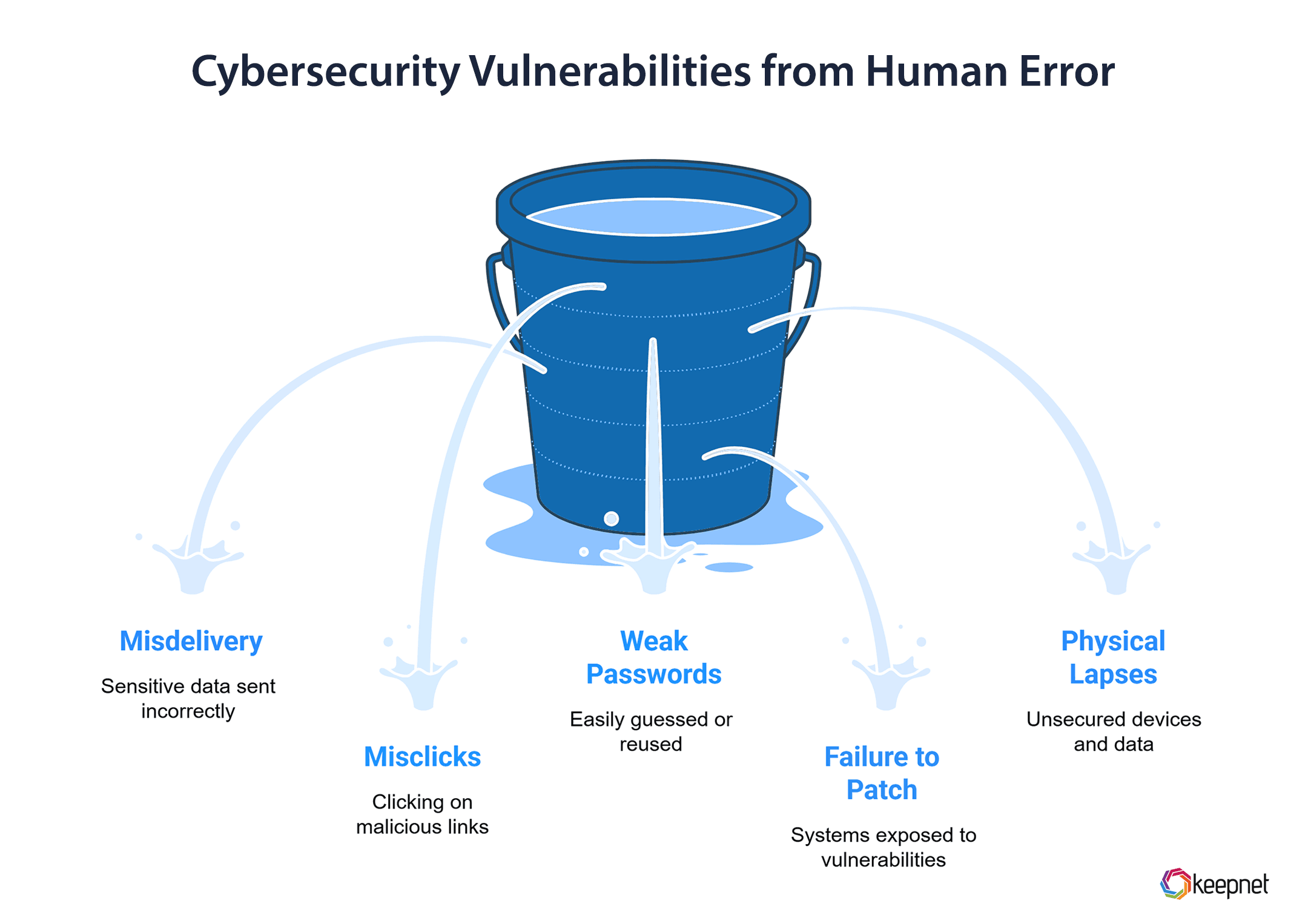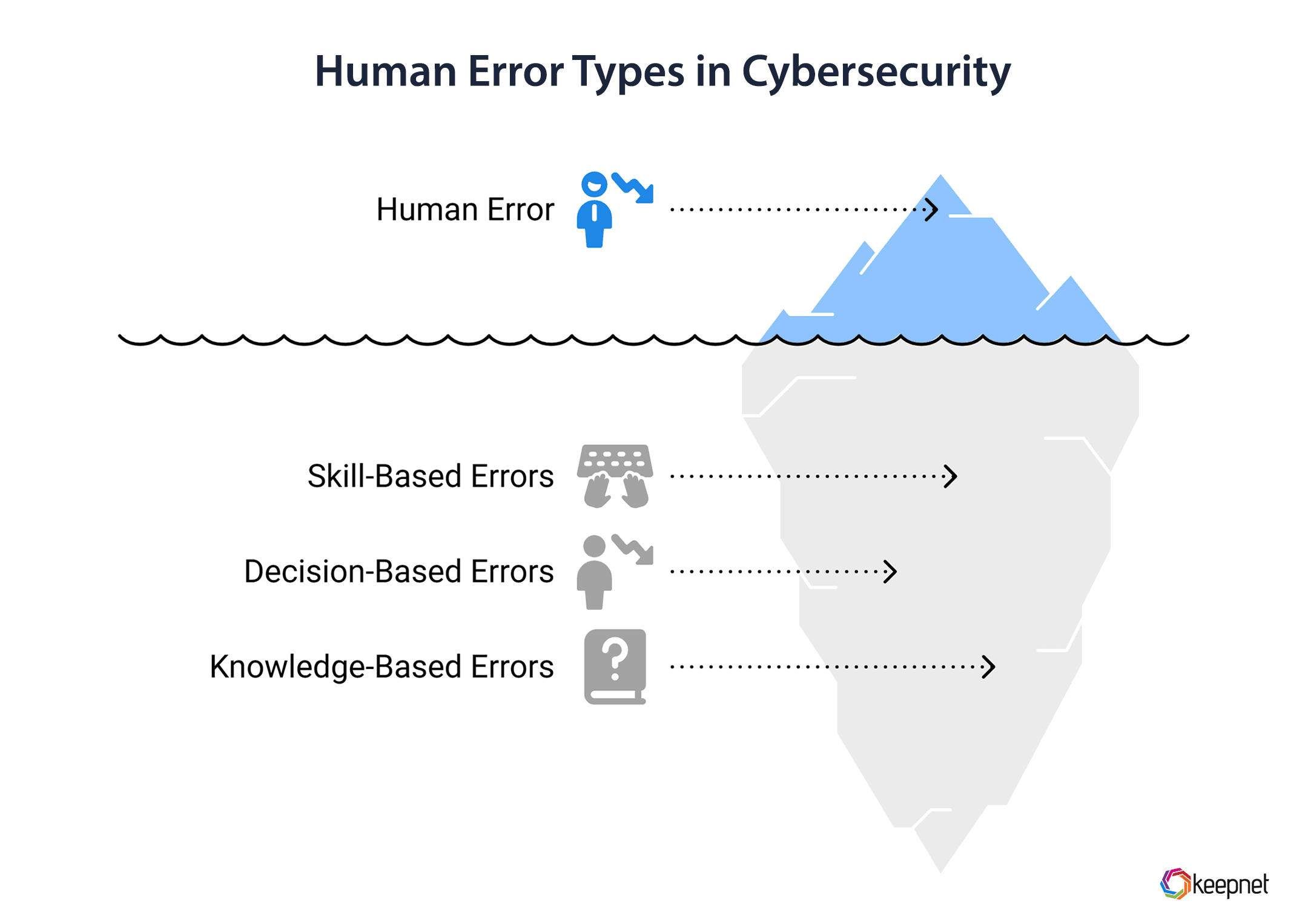The Role of Human Error in Cyber Security in 2025
Human error remains the top cause of data breaches in 2025. Discover how mistakes like clicking phishing emails and weak passwords expose organizations—and how to reduce this risk.
When discussing cybersecurity, the spotlight often falls on firewalls, encryption, and cutting-edge tools—yet human error in cybersecurity remains the most overlooked and devastating vulnerability. Shockingly, 95% of breaches stem from simple mistakes, proving that even the strongest systems crumble when people make avoidable missteps. From phishing traps and reused passwords to cloud misconfigurations or ignored software patches, human error in cyber security creates gaps that attackers exploit ruthlessly.
A Stanford study reinforces this: 88% of breaches originate in actions like clicking malicious links or using weak credentials. Human error in computer security highlights a universal truth: technology alone can’t compensate for human oversight. Addressing this requires not just better tools but smarter training, proactive policies, and a culture that prioritizes vigilance over convenience.
This guide explores the root causes, real-world examples, and proven strategies to reduce human-related errors.
What Is Human Error in Cybersecurity?

Human error occurs when individuals unintentionally make decisions or take actions that result in a security breach. This can be as simple as using a weak password or clicking on a phishing email. These mistakes may seem minor, but they can have a serious impact, putting an entire organization’s data at risk.
With numerous digital tools and platforms available today, employees are often overwhelmed by the number of passwords they must manage and the security protocols they need to follow. This increases the likelihood of making mistakes, such as forgetting to update software or incorrectly configuring security settings.
What is the Role of Human Mistakes and Their Impact on Cybersecurity
Human mistakes are among the most significant factors contributing to increased cybersecurity risks. Employees frequently mishandle confidential information, inadvertently sharing sensitive data with unauthorized individuals or storing it insecurely.
These errors create vulnerabilities easily exploited by cyber criminals, who often rely on phishing attacks to deceive users into revealing passwords, financial data, or personal details. Implementing preventive measures such as multi factor authentication can greatly mitigate these risks by ensuring that a single error does not lead to critical breaches.
Addressing human mistakes requires organizations to adopt strategies aimed at minimizing cybersecurity risks in the long term. Comprehensive training programs focused on recognizing cyber threats and adhering to security best practices are essential to reduce human error.
Regular phishing tests can heighten awareness and improve employee preparedness against real-world threats. By continuously educating employees and encouraging a culture of cybersecurity vigilance, organizations can significantly enhance their overall security posture and resilience against cyber criminals.
Why Does Human Error Happen?
Human error in cybersecurity isn’t just about carelessness. It usually stems from a few key factors. One of the biggest reasons is pressure and distractions. Tight deadlines, multiple tasks, or constant notifications can easily lead to someone overlooking critical security steps. Another big factor is a lack of awareness. Many employees aren’t trained well enough to spot phishing emails or understand the importance of basic security practices. Decision-based errors also play a role, where someone makes a mistake based on incomplete or incorrect information. For instance, an employee might delay an important software update, not realizing how critical it is, or fall for a well-disguised phishing scam.
Common Examples of Human Error in Cybersecurity
Here are some of the most common ways human error shows up in cybersecurity:
- Misdelivery: This happens when sensitive information is accidentally sent to the wrong person, like emailing a confidential document to an unintended recipient.
- Misclicks: Clicking on a malicious link in an email or downloading a harmful attachment is a common mistake, often made when employees are rushed.
- Weak Passwords: Using easily guessable passwords, reusing the same password for multiple accounts, or storing passwords insecurely are all examples of password-related human errors.
- Failure to Patch: Many breaches occur because employees or IT teams don’t install critical security updates in time, leaving systems exposed to vulnerabilities.
- Physical Security Lapses: Leaving devices unlocked or unattended, or failing to securely store physical copies of sensitive data, can also lead to breaches.
Human Error Types in Cybersecurity
Human error is a critical vulnerability in cybersecurity, but not all mistakes are the same. By categorizing errors into skill-based (routine slips) and decision-based (judgment lapses), and knowledge-based human errors organizations can tailor strategies to address root causes. Let’s break down the types of human error:

1. Skill-Based Errors: The "Oops" Moments
These occur during routine tasks, often due to distraction, fatigue, or haste. Even trained individuals make these mistakes.
Examples:
- Accidental Data Exposure: Sending sensitive files to the wrong email recipient or uploading data to public cloud storage
- Physical Security Lapses: Leaving devices unlocked in public spaces or misplacing unencrypted USB drives.
- Misconfigurations: Overlooking security settings (e.g., leaving cloud storage “public” due to rushed setup).
- Typos in Critical Fields: Mistyping a URL and landing on a phishing site.
Mitigation Strategies of Skill-Based Human Errors:
- Automate Repetitive Tasks: Use tools to auto-patch software, encrypt data, or verify email recipients.
- Checklists & Double-Checks: Implement protocols for configuring systems or sharing sensitive data.
- Physical Safeguards: Require auto-lock features on devices and secure disposal of hardware.
2. Decision-Based Errors: The "I Thought It Was Fine" Mistakes
These stem from poor judgment, lack of awareness, or cognitive biases. They often reflect gaps in knowledge or training. Examples:
- Falling for Phishing/Social Engineering Attack: Clicking malicious links or sharing credentials due to urgency or trust.
- Weak/Reused Passwords: Prioritizing convenience over security.
- Ignoring Updates: Delaying patches because “it’s not urgent.”
- Bypassing Security Protocols: Disabling multi-factor authentication (MFA) for convenience.
Mitigation Strategies:
- Targeted Awareness Training: Simulate phishing attacks and teach employees to recognize red flags (e.g., urgency, mismatched URLs).
- Enforce Policies: Mandate MFA, password managers, and least-privilege access.
- Cultivate Security Culture: Reward proactive behavior (e.g., reporting suspicious emails).
3. Knowledge-Based Errors: The "I Didn’t Know" Factor
These occur when individuals lack the expertise to handle complex or unfamiliar scenarios. Examples:
- Misconfiguring firewalls due to unfamiliarity with tools.
- Failing to recognize novel attack vectors (e.g., zero-day exploits).
Mitigation:
- Continuous Learning: Provide advanced training for IT teams.
- Expert Support: Partner with cybersecurity consultants for audits and guidance.
Statistics and Trends on Human Error in Cybersecurity
Let's dive into statistics, trends and facts on human error in information security 2025:
- 95% of cybersecurity issues involve a human element.
- 26% of employees fell for a phishing email at work.
- 17% of employees accidentally emailed the wrong external party.
- 49% of breaches were due to personal information being sent to the wrong recipient.
- 33% of breaches involved accidental disclosure or publication of personal data.
- 6% of breaches were due to not using BCC in emails.
- 5% of breaches were from misplacing paperwork or storage devices.
- 5% of breaches were from unauthorized verbal disclosures.
- 51% of employees made security mistakes when tired.
- 50% of employees made security mistakes when distracted.
- 50% of misdirected emails were due to pressure to send emails quickly.
- 49% of misdirected emails were due to not paying attention.
- 47% of misdirected emails were due to distraction.
- 42% of misdirected emails were due to fatigue.
- 54% of employees fell for phishing scams because they perceived the email as legitimate. .
- 29% of companies lost a customer or client due to a misdirected email.
- 21% of employees lost their jobs after sending data to the wrong person.
- 35% of employees had to notify customers about data loss due to misdirected emails.
- 44% of employees sent apology emails for data loss incidents caused by misdirected emails.
- 21% of employees did not inform their IT team about email security mistakes.
- 31% of cloud data breaches were attributed to misconfiguration or human error.
- 22% of organizations regarded human error as their topmost concerning threat in 2024.
- 43% of breaches were due to insider threats (both accidental and intentional).
Major Data Breaches Caused by Human Error in 2025
Human error has been responsible for some of the biggest data breaches in recent years. Here are a few high-profile examples of human error that caused data breaches:
PowerSchool Data Breach
- Date: January 2025
- Details: PowerSchool, an edtech company serving over 18,000 schools, experienced a breach when hackers accessed its customer support portal using a single compromised credential. This was likely due to phishing or poor password practices by an employee.
- Impact: Over 62 million students and 9.5 million teachers were affected, with personal data exposed across North America and the UK.
Musk’s DOGE Breach
- Date: February 2025
- Details: The Department of Government Efficiency (DOGE), tied to Elon Musk’s businesses, suffered a breach when private-sector employees accessed sensitive federal data without authorization. This suggests errors in access controls or inadequate training.
- Impact: Millions of Americans had their data exposed, raising national security concerns.
Bankers Cooperative Group, Inc. Breach
- Date: Reported January 14, 2025 (attack in August 2024)
- Details: Hackers accessed sensitive customer information through an employee’s email account at Bankers Cooperative Group, Inc., likely via phishing or weak password security.
- Impact: The number of affected individuals is unspecified, but the breach’s significance is noted in financial sector reports.
Mitigating Human Error with Keepnet’s Human Risk Management Platform
Human error is one of the leading causes of cybersecurity breaches, but businesses can take significant steps to mitigate this risk using Keepnet’s Extended Human Risk Management Platform. Keepnet offers a powerful combination of phishing simulations, security awareness training, and fast incident response, all designed to reduce the likelihood and impact of human mistakes, the weakest link in cybersecurity.
Keepnet’s phishing simulations immerse employees in realistic attack scenarios, including email phishing, vishing (voice phishing), and smishing (SMS phishing). By exposing staff to these threats in a controlled environment, organizations have seen a 90% reduction in high-risk behaviors.
On the training side, Keepnet’s Security Awareness Training provides engaging and diverse content, using gamification and SMS delivery to boost engagement. With a tailored 12-month training plan, success rates have increased from 50% to 94%, and training completion rates have reached 99%.
In the event of a potential security breach, phishing forensics and incident response tools help businesses respond quickly. By integrating with SOAR platforms and using automated workflows, Keepnet speeds up phishing investigations by 168 times and boosts phishing reporting by 92%, allowing organizations to act swiftly to mitigate damage.
Keepnet provides a comprehensive, all-in-one solution for managing human risk. By leveraging these tools, businesses can transform human error from a cybersecurity vulnerability into a key line of defense.
Watch the video below to learn more details about Keepnet’s Human Risk Management Platform.
Editor's Note: This article was updated on April 29, 2025.